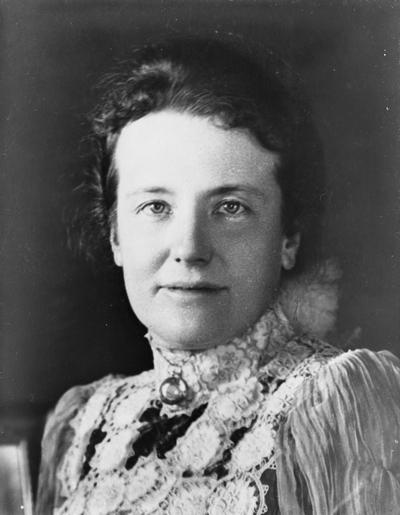Edith Kermit Carow Roosevelt (Edith Kermit Carow Roosevelt)

Roosevelt was born in Norwich, Connecticut, to merchant Charles Carow (1825–1883) and Gertrude Elizabeth Tyler (1836–1895). Gertrude’s father Daniel Tyler (1799–1882) served as Union general in the American Civil War. Edith grew up next door to Theodore “T.R.” Roosevelt, Jr. (1858–1919) (the elder son of philanthropist Theodore Roosevelt, Sr. and socialite Martha Stewart “Mittie” Bulloch) in New York and was best friends with his younger sister Corinne (1861–1933). She was T.R.’s first real playmate outside his immediate family. Roosevelt recalled, “I was but four years old, when my mother came to the nursery to say that the Roosevelt children were coming to spend the day. I remember hiding my old and broken toys and my nurse explaining that the shabbiest of all might give the visitors the most pleasure.” Martha Stewart Bullock became aware of the “growing intimacy” between Edith and her son and invited her to join him for kindergarten tuition. During her childhood, Edith was known as “Spotless Edie.”
Edith and her sister Emily Tyler Carow (1865—1939) were brought up in an environment of comfort and tradition. An infant brother, Kermit (February 1860 — August 1860) died one year before her birth. At Miss Comstock’s school, Edith acquired the proper finishing touch for a young lady of that era. A quiet girl who loved books, she was often T.R.’s companion for summer outings at Oyster Bay, Long Island; but this ended when he entered Harvard College. Although she attended his wedding to Alice Hathaway Lee in 1880, their lives ran separately until 1885.
T.R. proposed to Edith on November 17, 1885 and she accepted. However, for appearance’s sake, the young widower delayed the announcement. They married on December 2, 1886, at St. George’s Church of Hanover Square, in London, England. On the day of the wedding, a quiet affair with few guests, the London fog was so thick that it filled the church. The groom was visible however, for he wore bright orange gloves. His best man was Cecil Arthur Spring-Rice, who later served as British ambassador to the United States during World War I and maintained a close friendship with the couple for the rest of his life. After a 15-week honeymoon tour of Europe, the newlyweds settled down in a house on Sagamore Hill, at Oyster Bay. Mrs. Roosevelt, reserved and efficient, managed the household budget. Throughout T.R.’s intensely active career, family life remained close and entirely delightful.
After William McKinley’s assassination, Mrs. Roosevelt assumed her new duties as First Lady with characteristic dignity. She meant to guard the privacy of a family that attracted everyone’s interest, and she tried to keep reporters outside her domain. The public, in consequence, heard little of the vigor of her character, her sound judgment, her efficient household management.
As First Lady, her first “symbolic” activity was to throw open the windows to let in sunlight and fresh air while dissipating the “dark, musty” atmosphere. Roosevelt rearranged the furniture after this as well, but a few days later, when the White House was “partly settled,” Edith collapsed into a “heavy sleep” for 48 hours. She converted the traditional weekly levees to musicales, remodeled the White House at a cost of $475,000 into what the president described as “a simple and dignified dwelling for the head of a republic.” During T.R.’s administration, the White House was unmistakably the social center of the land. Beyond the formal occasions, smaller parties brought together distinguished men and women from varied walks of life. Three family events were highlights: the debut of her stepdaughter Alice Lee Roosevelt in 1902, the wedding of “Princess Alice” to Nicholas Longworth in 1906, and Ethel’s debut. A perceptive aide described the First Lady as “always the gentle, high-bred hostess; smiling often at what went on about her, yet never critical of the ignorant and tolerant always of the little insincerities of political life.”
On July 14, 1918, her son Quentin died during aerial combat over France. After her husband’s death in 1919, she traveled abroad but always returned to Sagamore Hill as her home. Roosevelt had to get away from her own home due to it reminding her of her late husband. In New York City, she arranged for her and her maid to sail for Europe on February 5, 1919. After suffering from a severe headache over the weekend, Roosevelt was finally able to monitor Quentin’s grave on February 18, 1919. Roosevelt arranged with representatives for ninety residents of Chamery for a fountain in his memory to be erected since his body was to remain in France.
She kept till the end her interest in the Needlework Guild, a charity which provided garments for the poor, and in the work of Christ Church at Oyster Bay. She established a second residence in the Tyler family’s ancestral hometown of Brooklyn, Connecticut. Mrs. Roosevelt came out of retirement and campaigned briefly for Herbert Hoover in his bid for re-election in the 1932 presidential election, thus campaigning against her cousin-in-law Franklin D. Roosevelt. She died at her Oyster Bay home in New York on September 30, 1948, at the age of 87 and is interred next to her husband in Youngs Memorial Cemetery near Oyster Bay, New York.
Born
- August, 06, 1861
- USA
- Norwich, Connecticut
Died
- September, 30, 1948
- USA
- Oyster Bay, New York
Cemetery
- Youngs Memorial Cemetery
- Oyster Bay, New York
- USA





